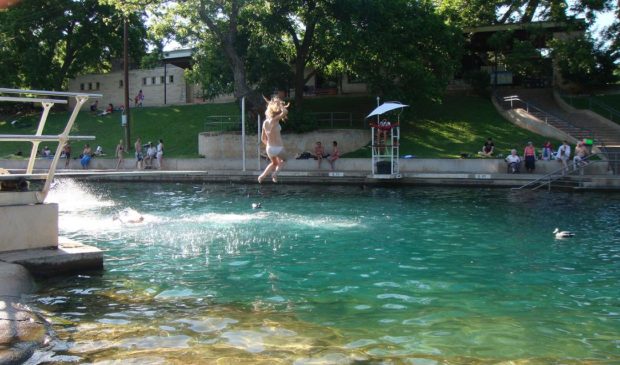Salamanders key as city considers improvements at Barton Springs
Thursday, May 31, 2018 by
Chad Swiatecki A variety of improvements totaling millions of dollars for the area around Barton Springs will move slowly forward in 2019 and 2020, with the protection of the endangered Barton Springs salamander as the primary consideration of city staff.
At a combined meeting of the Parks and Recreation Board and the Environmental Commission on Tuesday, members heard about plans for the ambitious renovations of the Eliza Springs below-ground amphitheater and the circular masonry-walled Sunken Gardens, both historic structures closed from public use that have seen considerable deterioration and are required to be improved because they provide habitat for the federally protected salamander.
“The thing to remember is these sites were closed to public recreation in order that Barton Springs Pool could remain open even though that’s the largest salamander habitat that we have,” said Laurie Dries, a salamander ecologist who previously served on the city’s salamander conservation team. “We do this with the idea and expressed purpose of educating the public about the ecology of our water systems and our salamanders and wildlife.”
Work on both historic structures is in the very early phase, with Parks and Recreation Department staff planning to spend 2019 studying the condition and improvement options for Eliza Springs in hopes of seeing work begin by 2021 at the latest. The improvements to Sunken Gardens are considered an easier and possibly less expensive fix, but the crumbling concrete and overall dire condition of Eliza Springs makes it a priority, said Kim McKnight, environmental conservation program manager for PARD.
McKnight reminded the combined board repeatedly that there is no identified funding for the desired improvements but said there is the possibility that the city could allow use of money from its portion of the Hotel Occupancy Tax, a pool of more than $100 million that is allowed for use on projects that in some way contribute to the city’s tourism economy.
That requirement would likely trigger some sort of educational activities or other programming for visitors to be incorporated into the structures once they are improved, but McKnight said there is currently a lot of uncertainty around competing projects trying to qualify for funds.
“(City Council) has signaled a desire to fund historic tourist sites with a funding stream that had not previously been available,” she said. “This is a brand-new process, there’s working groups and there’s nothing set in stone, so I can’t emphasize enough how many pieces are moving simultaneously. I think it’s wise for us to not count on something this early on.”
Also discussed at the session were the planned 2020 improvements to the bathhouse at Barton Springs, funding for which was included in a 2012 bond issue.
Because of the likely high cost of the many projects discussed on Tuesday, members of the two boards agreed to lobby their respective Council members and consider separate resolutions of support at their upcoming meetings.
Multiple times during the meeting, the board and commission members questioned the overall utility of the finished projects that will be largely closed off from public use, as well as the stewardship of using millions of tax dollars to protect salamander habitat.
Asked about the other ways the city could have spent the $2.3 million spent on a recent reconstruction of a stream that flowed into the springs, acting PARD Director Kimberly McNeeley said the city is required to strike a balance between the salamanders’ needs and the popularity of Barton Springs as a public attraction.
“You could think of it as we spent $2.3 million that allowed us to keep the pool open and continue the opportunity to utilize Barton Springs as a recreational amenity,” she said. “Think of it as a $2.3 million investment that allows us to use this recreational amenity for years upon years.”
Photo by Todd Dwyer (CC BY-SA 3.0), via Wikimedia Commons.
The Austin Monitor’s work is made possible by donations from the community. Though our reporting covers donors from time to time, we are careful to keep business and editorial efforts separate while maintaining transparency. A complete list of donors is available here, and our code of ethics is explained here.
You're a community leader
And we’re honored you look to us for serious, in-depth news. You know a strong community needs local and dedicated watchdog reporting. We’re here for you and that won’t change. Now will you take the powerful next step and support our nonprofit news organization?




